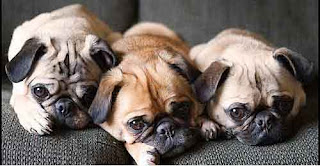The Pug has a square, thickset, stocky compact, body, with a sleek, soft coat that comes in apricot, fawn, black and silver - all with a short, flat, black muzzle and velvety ears. Rose shaped ears are preferred. Moles on the cheeks are considered beauty spots. The eyes are prominent, expressive, dark and lustrous. The teeth should meet in a slightly undershot bite. The back is short, with a level topline. Their tail lays in a tight curl, or in the best specimens, a double curl on the back. Their limbs are straight and strong which gives them a jaunty, rolling gait that is quite distinctive.
Temperament
A Pug is "a lot of dog in a small space." They are perky, rambunctious and loyal, affectionate and loving, with a happy disposition. They are playful and charming. Clever and mischievous - with a heart-winning personality. They can be a bit willful if they sense they are stronger minded than the humans around them. Highly intelligent, it bores easily with repetitive training practices. Pugs are sensitive to the tone of your voice, so harsh punishment is unnecessary. They need an owner who is calm, yet firm, confident and consistent with the rules. The dog is neither excitable nor dull. They are good watchdogs, very devoted and are not yappers. Pugs get along well with other dogs and pets, and they behave impeccably with both children and visitors. Be sure to be your Pug's pack leader. Pugs who do not have strong human leaders can become jealous, and begin to display guarding behaviors, such as guarding furniture, food, toys, or other spots in the house. This behavior only happens when dogs are allowed to take over. These behaviors can be corrected when the owners start displaying the proper leadership. Dogs who feel they need to run the home are not as happy as dogs who know they are human followers, as it is very stressful for a dog to need to keep "his" humans in line.
Height, Weight
Height: Dogs 12-14 inches (30-36 cm.) Bitches 10-12 inches (25-30 cm)
Weight: Dogs 13-20 pounds (6-9kg.) Bitches 13-18 pounds (6-8 kg)
Health Problems
Pugs catch colds easily and are stressed by hot and cold weather. They are prone to allergies and the short muzzle contributes to chronic breathing problems. (Pugs suffer from poor ventilation.) They are not the easiest whelpers. Expect Cesarean Section if breeding. There is a chance of keratites (inflammation of the cornea) and ulcers on the cornea. The delicate eyes are prone to weeping. This breed tends to wheeze and snore, but on the whole is a very easy-care dog. Do not overfeed a Pug, as they will eat more than is good for them, quickly becoming obese and living much shorter lives. Prone to skin problems. Pone to Pug Dog Encephalitis (PDE), an inflammation of the brain that strikes adolescent Pugs usually between the ages of 2 and 3. The cause is unknown.
Living Conditions
The Pug is good for apartment life. It is relatively inactive indoors and will do okay without a yard. Cannot withstand hot or cold weather and should be kept indoors at a comfortable temperature.
Exercise
Pugs are strong dogs with short straight legs. They need to be taken on daily walks. While out on the walk the dog must be made to heel beside or behind the person holding the lead, as instinct tells a dog the leader leads the way, and that leader needs to be the human. They enjoy energetic games and will keep in better health if given regular exercise. But be careful not to over do it, especially if you see them start to wheeze.
Origin
One of the older breeds, the Pug is believed to have originated before 400 BC in Asia. There is somewhat of a debate over the origin of the Pug. Some experts think it came from the Lowlands, brought back from the Far East by Dutch traders. It is possibly of Oriental stock, descended from a short-haired Pekingese, but another theory is, it is the result of crossing a small Bulldog. Yet another school of thought is that it is a miniature form of the rare French Mastiff called Dogue de Bordeaux. Pugs were a favorite of the artist Hogarth, who included his pet Pug "Trump" in several of his works. From the sixteenth century, it became a fashionable adornment of the European Courts, reaching its peak of popularity in Victorian times. He was a pet at Tibetan monasteries and later traveled to Japan. The Pug then came to Europe, where the endearing little dog was the pet of royalty in several countries and even became the official dog of the House of Orange in Holland. A Pug saved William, Prince of Orange's life by alerting him to the approaching Spaniards in 1572 at Hermingny. Napoleon's wife, Josephine, sent secret messages to her husband under the collar of her Pug while she was in prison. When the British overran the Chinese Imperial Palace in 1860, they discovered several Pugs and Pekinese, and brought the little dogs back to England with them. The AKC recognized the Pug in 1885 and the breed has since become a popular companion dog. Some of the Pug's talents include: watchdog and performing tricks.







Tidak ada komentar:
Posting Komentar